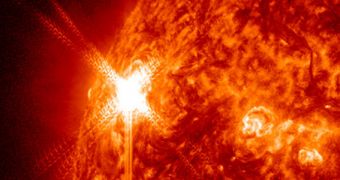Last Thursday, on November 3, the Sun released a powerful solar flare, which astronomers classified as an X1.9-class event. The X class contains the most powerful solar eruptions ever recorded. This year already saw two such events occur, which is rather unusual.
The Sun is currently heading towards a new maximum, which is scheduled to reach around 2012-2013. This is the explanation for the large number of sunspots, solar flares and coronal mass ejections that solar observatories continuously detect.
A statement from NASA says that the event “triggered some disruption to radio communications on Earth beginning about 45 minutes later. Scientists are continuing to watch this active region as it could well produce additional solar activity as it passes across the front of the Sun.”
NASA's SDO and STEREO spacecraft monitored the event as it unfolded, starting at 4:27 pm EST (2027 GMT), Space reports. “This large and complex active region just rotated onto the disk and we will watch it for the next 10 days,” officials from the SDO science team explained.

 14 DAY TRIAL //
14 DAY TRIAL //